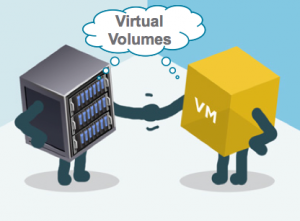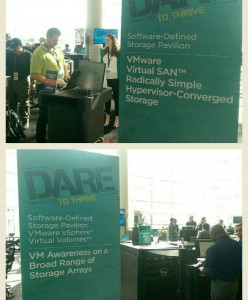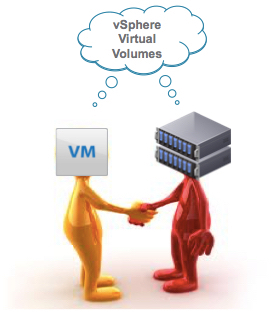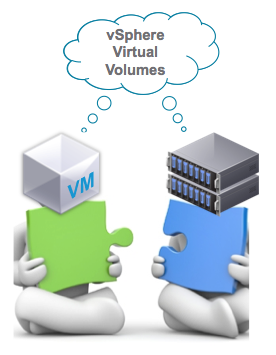 In 2011 VMware introduced block based VAAI APIs as part of vSphere 4.1 release. This APIs helped improving performance of VMFS by providing offload of some of the heavy operations to the storage array. In subsequent release, VMware added VAAI APIs for NAS, thin provisioning, and T10 command support for Block VAAI APIs.
In 2011 VMware introduced block based VAAI APIs as part of vSphere 4.1 release. This APIs helped improving performance of VMFS by providing offload of some of the heavy operations to the storage array. In subsequent release, VMware added VAAI APIs for NAS, thin provisioning, and T10 command support for Block VAAI APIs.
Now with Virtual Volumes (VVOLs) VMware is introducing a new virtual machine management and integration framework that exposes virtual disks as the primary unit of data management for storage arrays. This new framework enables array-based operations at the virtual disk level that can be precisely aligned to application boundaries with the capability of providing a policy-based management approach per virtual machine.
The question now is what happens to VAAI APIs (NAS and Block) and how will virtual volumes co-exist together?. With Virtual Volumes, aside from the data path, the ESX hosts also control of the connection path to the storage arrays. The Vendor Provider typically arranges the path to the storage arrays. In this case, virtual volumes can be considered as a richer extension of the VAAI NAS APIs. On July of last year I published an article in which I discussed the interoperability between VAAI and VVOLs during cloning operations in deferent scenarios “Virtual Volumes (VVols) vSphere APIs & Cloning Operation Scenarios” consider having another look. Now let’s go over a set of interaction scenarios between the VAAI APIs and Virtual Volumes.
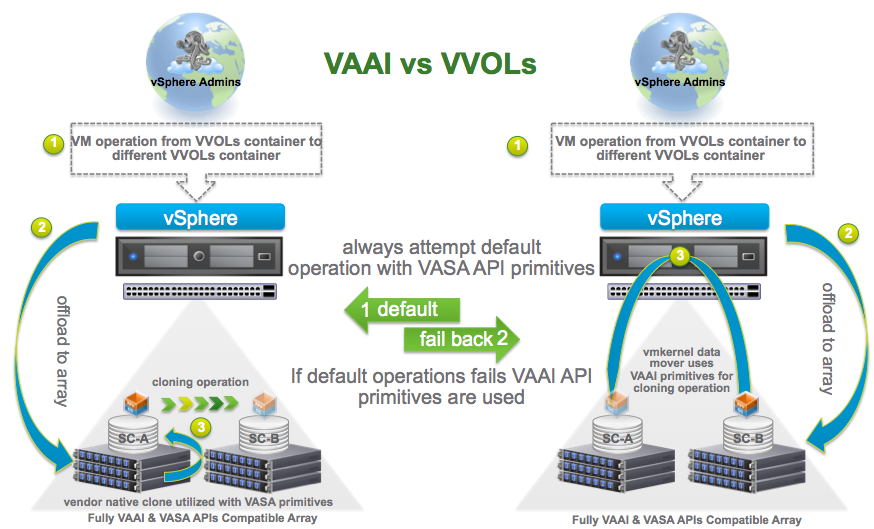
VAAI Block and VVOLs:
VAAI Block defines basic SCSI primitives, which allows vSphere (primarily VMFS) to offload pieces of its operations to the array. There is still a heavy dependency on VMFS playing the role of an orchestrator and sending individual VAAI Block command to the storage array.
With VVOLs, the storage array systems are aware of virtual machine’s disk and hence they can efficiently perform operations such as snapshots, clones, and zeroing operations on the virtual machines disks. But still VAAI Block and thin-provisioning primitives co-exists with VVOLs.
- ATS – All config VVOLs objects that are stored in a Block VVOLs datastore are formatted with VMFS and hence require supporting ATS commands. This support is detected based on ATS support for a PE LUN to which VVOLs are bound.
- XCOPY – With VVOLs, ESX will always try to use array based VVOLs copy mechanism defined using copyDiffsToVirtualVolume or CloneVirtualVolume primitives. If these are not supported, it will fall back to software copy. Since software copy involves copying data between Protocol Endpoint (PE) LUNs and VMFS LUN, there is still potential to use XCOPY command during software data copy. When falling back to software copy, vSphere will use the XCOPY command when moving a virtual machine from a VMFS datastore to VVOLs datastore or between two VVOLs datastores. In the first release, vSphere will not try to use XCOPY if the virtual machine is moving from VVOLs datastore to VMFS datastore. vSphere will detect the support for XCOPY for individual VVOLs based on the support of VAAI XCOPY on PE LUN to which it is bound.
- Block Zeroing – Main purpose of this primitive is to initialize thick disks provisioned on VMFS datastores. So this primitive is not used for VVOLs as in VVOL, VMFS on config VVOLs only contains small descriptor files. Main purpose of this primitive is to initialize thick disks provisioned on VMFS datastores. With VVols VM provisioning type is specified as part of profile information passed during VVOL creation. Config VVol which are formatted VMFS are “thin” by definition. Also size of config VVol is very small (default 4GB) and it contains small files such as disk descriptors, vm config files, stats and logs data. So Block Zeroing primitive is not used for VVOLs by vSphere.
VAAI NAS and VVOLs:
Unlike SCSI, NFSv3 is a frozen protocol, which means all features of VAAI NAS came via private RPCs issued by vendor plugins. VVOLs extends this model of communicating outside basic protocol. VVOLs defines the rich set of VASA APIs to allow offload of most of the vSphere operations. With vSphere 6.0, existing VAAI NAS will continue work but VVOL datastores will offer richer and faster experience than VAAI NAS. Also, VVOLs doesn’t need any vendor specific plugin installation. Another noteworthy point regarding NAS VAAI and storage vMotion is that NAS VAAI snapshots cannot be migrated, when an attempt is made to migrate a virtual machine with NAS VAAI “snapshots”, the snapshot hierarchy is collapsed and all snapshot history is lost. This is not the case with VVOLs, and further we can translate snapshot hierarchies between NFS (Non-VAAI)/VMFS/VSAN/VVol (any source->target combination of the 4).
VAAI Thin-Provisioning and VVOLs:
- Soft Threshold Warnings – similar to a VMFS datastore with TP support, Soft threshold warning for any VVOL virtual machine’s I/O, will be seen in vCenter. Also the corresponding container gets flagged appropriately. The container gets the yellow warning icon when soft threshold warning is issued. Essentially this could be potentially confusing for vSphere admin as this warning is virtual machine specific and warning message doesn’t provide the details on which virtual machine has the problem. This will be corrected in a future update.
- Hard Threshold Warnings – Hard threshold warning behavior is similar to that on VMFS datastore.
When VVOL virtual machine’s I/O gets a hard threshold warning, it will stun the corresponding virtual machine. Administrator can resume the virtual machine after provisioning more space or can completely stop the virtual machine.
- UNMAP – Since there are no disks managed by VMFS, vSphere will not be actively using the UNMAP primitive. vSphere will not actively used UNMAP primitive. Although it will pass through UNMAP to backing VVOLs when guest issues it. Although it will issue UNMAP when guest issues it like XCOPY and ATS, vSphere will detect support for UNMAP for individual VVOLs based on the support of VAAI UNMAP on a Protocol Endpoint LUN to which it is bound. Another thing is that vSphere will not enforce any of the alignment criteria when UNMAP is issued by the guest. This behavior is very similar to the one found with an RDM LUN. With VVOLs UNMAP commands going from the guest directly to the storage array the same way we send all I/O, and the array will now finally see all the individual UNMAP commands guest operating systems issues. For example, a Windows Server 2012 will immediately become a source of UNMAP commands. On the other hand for the Linux, the filesystem checks the SCSI version supported by the virtual device and won’t issue an UNMAP with the current level of SCSI support we present (SCSI-2). That is something that will be addressed in a future release.
Now let’s identify the supported operations and behavior for the different primitives.
Primitives Supported Operations and Behavior
Powered On Storage vMotion without snapshots
For a powered on VM without snapshots, the Storage vMotion driver coordinates the copy. The Storage vMotion driver will use the data mover to move sections of the current running point. The data mover will employ “host orchestrated hardware offloads” (XCOPY, etc) when possible.
Block VAAI & Block VVOLs:
– Bitmap APIs will be used to determine only the relevant blocks to migrate (Space efficiency optimization)
– XCOPY will be used to migrate (host orchestrated offload)
NAS VAAI
– No optimizations
NAS VVOL
– Bitmap APIs will be used to determine only the relevant blocks to migrate (Space efficiency optimization)
Powered On Storage vMotion with snapshots
For a powered on VM with snapshots, the migration of snapshots is done first, then the Storage vMotion driver will use the data mover to move the current running point.
Block VAAI
– Bitmap APIs will be used to determine only the relevant blocks to migrate (Space efficiency optimization)
– XCOPY will be used to migrate snapshots + current running point
Block VVOL
– Bitmap APIs will be used to determine only the relevant blocks to migrate (Space efficiency optimization)
– The cloneVirtualVolume and copyDiffsToVirtualVolume VASA APIs will be used to migrate all snapshots (Full hardware offload)
– XCOPY will be used to migrate the current running point (host orchestrated offload)
NAS VAAI
– NAS VAAI cannot migrate snapshots
– No further optimization
NAS VVOL
– Bitmap APIs will be used to determine only the relevant blocks to migrate (Space efficiency optimization)
– The cloneVirtualVolume and copyDiffsToVirtualVolume VASA APIs will be used to migrate all snapshots (Full hardware offload)
Powered Off Storage vMotion without snapshots
For a powered off VM, the Storage vMotion driver is not in the picture. So, effectively a Storage vMotion of a powered off VM is a logical move (Clone + Delete Source).
Block VAAI
– Bitmap APIs will be used to determine only the relevant blocks to migrate (Space efficiency optimization)
– XCOPY will be used to migrate current running point
Block VVOL
– Bitmap APIs will be used to determine only the relevant blocks to migrate (Space efficiency optimization)
– The cloneVirtualVolume VASA API will be used to migrate the current running point (Full hardware offload)
– The copyDiffsToVirtualVolume VASA APIs will be used to migrate all snapshots (Full hardware offload)
NAS VAAI
– NAS VAAI clone offload will be employed to migrate the current running point
NAS VVOL (Same as block VVOL)
– Bitmap APIs will be used to determine only the relevant blocks to migrate (Space efficiency optimization)
– The cloneVirtualVolume VASA API will be used to migrate the current running point (Full hardware offload)
– The copyDiffsToVirtualVolume VASA APIs will be used to migrate all snapshots (Full hardware offload)
Powered off Storage vMotion with snapshots
– Same general idea as above, just with snapshots too…
Block VAAI
– Bitmap APIs will be used to determine only the relevant blocks to migrate (Space efficiency optimization)
– XCOPY will be used to migrate current running point + snapshots
Block VVOL
– Bitmap APIs will be used to determine only the relevant blocks to migrate (Space efficiency optimization)
– The cloneVirtualVolume VASA API will be used to migrate the current running point + snapshots (Full hardware offload)
NAS VAAI
– NAS VAAI cannot migrate snapshots
– NAS VAAI clone offload will be employed to migrate the current running point
NAS VVol (Same as block VVOL)
– Bitmap APIs will be used to determine only the relevant blocks to migrate (Space efficiency optimization)
– The cloneVirtualVolume VASA API will be used to migrate the current running point + snapshots (Full hardware offload)
– Enjoy
For future updates on Virtual SAN (VSAN), vSphere Virtual Volumes (VVOLs) and other Software-defined Storage technologies as well as vSphere + OpenStack be sure to follow me on Twitter: @PunchingClouds
